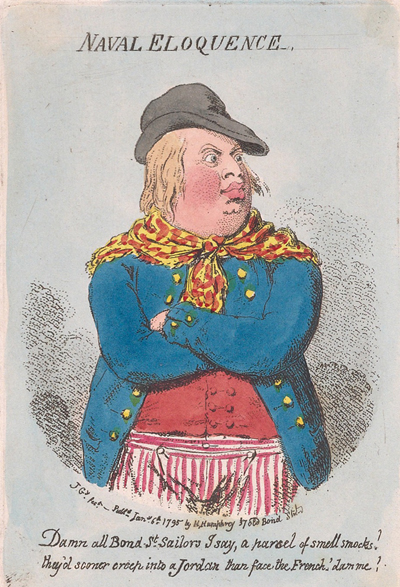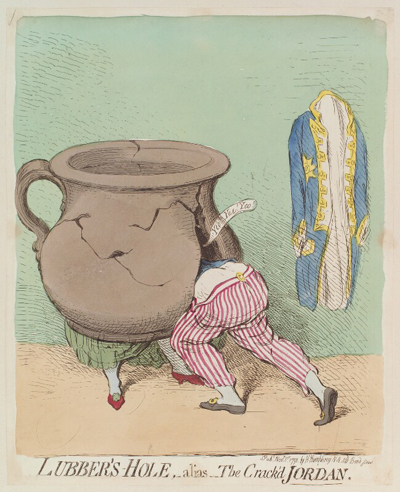Naval Eloquence
Naval Eloquence is one of a series of caricatured portraits (all listed as being published on January 6th, 1795) illustrating eight kinds of eloquence, and sometimes associated with particular, real-life individuals. For more about the series as a whole, see my Overview.

© Beinecke Rare Book and Manuscript Library, Yale University
Naval Eloquence was probably a late addition to the series. Unlike all the other prints in the "Eloquence" sequence, it does not appear to have been based on an earlier drawing supplied by the monogrammist AS (Annibal Scratch). So Gillray is likely to have "invented" it himself. The Duke of Clarence had been largely out of the public eye since his scandalous affair with the actress, Mrs. Dorothea Jordan in 1791. But Gillray may have been prompted to include him by the recent announcement in The Morning Post of a four volume historical novel, The Duke of Clarence to be published by "Lane, At the Minerva, Leadenhall Street." Or he may simply have been driven to it by the need to add one more panel to fill out the eight-panel version of the series.
Like Gillray's later Royal Lounger (1804), but unike the prints in the rest of the Eloquence series, Naval Eloquence is bitterly ironic, for, by 1795 the Duke of Clarence was the embodiment of everything the caption rails against.
Damn all Bond St Sailors I say, a parcel of smell smocks! they'd sooner creep into a Jordan than face the French! dam me!
The Duke had not seen active service since 1790, but continued to accumulate honorary titles, living on a reputation as a naval man even when he became King. The reference to creeping into a Jordan is no doubt intended to recall the Duke's (by now settled) relationship with Mrs. Jordan, but also perhaps to remind Gillray's audience of his notorious 1791 print, Lubber's Hole, alias the Crack'd Jordan.

© National Portrait Gallery, London
To be fair, Prince William apparently applied for naval employment during the war with France, according to the British Museum commentary, but his applications were either denied or ignored. But Gillray is not interested in excuses. Indeed, he has a long history of contrasting the wealth and privilege of the Royals with the poverty and hardship of the common soldier or sailor. And he did not hesitate to use an enlarged and improved version of the image and caption from Naval Eloquence five months later in the (naturally) ironic, A True British Tar
Sources and Reading
- Commentary from the British Museum on Naval Eloquence
- "William IV of the United Kingdom," Wikipedia
- "Dorothea Jordan," Wikipedia
Comments & Corrections
NOTE: Comments and/or corrections are always appreciated. To make that easier, I have included a form below that you can use. I promise never to share any of the info provided without your express permission.